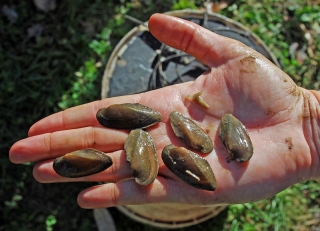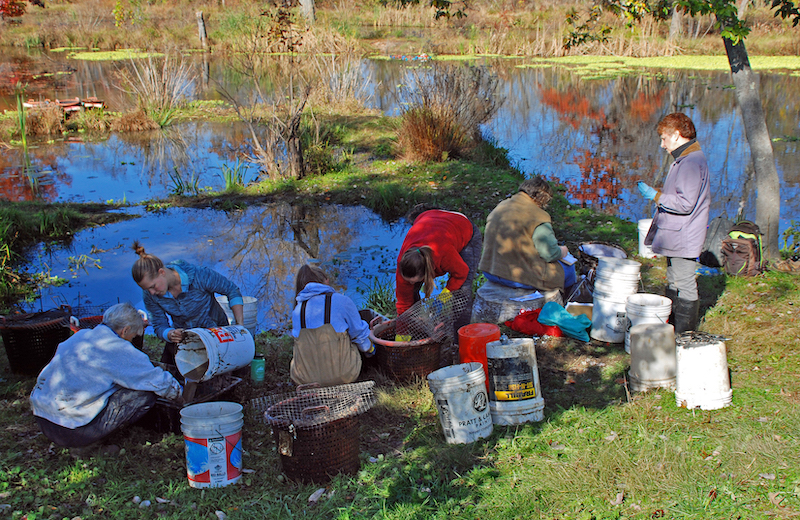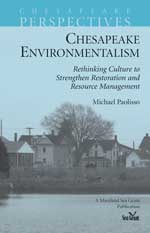Knauss legislative fellowships in Congress help build careers — and they're fun and educational. See our video and fact sheet for details.
The Maryland Sea Grant Bookstore will be closed for the winter holidays from Monday, December 15th to Friday, January 2nd and will not be taking orders during that time.
Mussels as a Matter of Policy
Amidst a constantly changing political scene, the environment and the policies set to solve conservation and restoration challenges seem to have earned a place at the top of many people’s priorities in recent years.
With more than 35 members of Congress signed on to the environmentally-focused Green New Deal to date, the consistent updates to the Chesapeake Bay Watershed Agreement, and the increase in local bans and taxes on various forms of plastic, laws and policy have become an increasingly useful catalyst for environmental improvements.
So where does that leave us when a nonprofit environmental organization wishes to put a species in its long-polluted river that it hopes will not only clean up runoff, but also increase biodiversity?
Such is the case facing the Anacostia Watershed Society, which is charged with looking after the health and well-being of the Anacostia River in Washington, D.C.
How do scientists even begin to execute research such as the mussel conservation project in the Anacostia River? What do you have to do to get mussels in? What has it taken mussel conservation projects come to fruition in the past decade?
|
|
|
The Anacostia Watershed Society (AWS) is getting mussels ready to overwinter in Kenilworth Aquatic Gardens. Photo: Jorge Montero, AWS |
We can look at scientists who are working to conserve freshwater mussel populations not only in Maryland and the District, but also look at the logistics of deploying mussels in the rivers of other states and cities that are working on similar conservation efforts.
Jess Jones, a biologist with the U.S. Fish and Wildlife Services, provides a simple answer to these questions: permits.
Working with freshwater mussel conservation in the Clinch and Powell rivers in Virginia and Tennessee, Jones says that those who want to add fish or shellfish to environments need either state or federal permits, and sometimes, both.
“Much of the reason the work is heavily-permitted is due to the fact that many mussel species are federally endangered,” he said.
Five of the eight mussels found in the Anacostia, for example, are listed as Species of Greatest Conservation Need, a list that the U.S. Geological Survey maintains to highlight species that are in danger due to loss of habitat, development, or climate change.
“Under natural conditions” Jones said, “ mussels are a very important part of a natural river ecosystem.” Jones emphasized that, prior to human disruption, mussels made up the majority of the biomass in rivers such as the Clinch and the Powell.
Permission to populate?
Obtaining the permits that could ultimately lead to the rejuvenation of these mussel populations is not a task that can be done by anyone. These permits are given to researchers with a lot of experience and typically with credentials and affiliations with federal and state entities. In the past, policy has focused more on funding for oyster conservation and less on freshwater mussel conservation as a means for improving water quality.
Matt Ashton, a senior biologist at the Maryland Department of Natural Resources (DNR), notes that attention toward mussel species has increased every year since his tenure at the agency.
“This wasn’t even on our radar 10 years ago as something to do...maybe within the last five years, and essentially every year after that,” Ashton said. “The number of news articles, magazine articles, and even our own press articles has increased.”
One reason for the increasing focus on mussels is partially just the Chesapeake Bay as a region catching up.
Ashton contrasts the timeline of the attention to mussels in the Chesapeake with the work of conservationists in the Southeast region of the country. “They’re about 10 to 20 years further than us in mussel conservation work, as they have more mussel species, and, specifically more endangered mussel species,” he said. “They’ve been doing the work out of necessity for longer.”
Alabama, for example, has more than 100 species of mussels, and about 20 of them are endangered. Maryland, on the other hand, has only 16 native mussel species with just two of those listed under the Federal Endangered Species Act. As more species are recognized in this part of the country as being rare or in decline, conservationists and researchers have concluded that our region also needs to conduct conservation projects that revive freshwater mussel populations in river habitats. While much of the focus to date has been on oyster restoration in the Chesapeake Bay, mussels would likely live longer and perform better in freshwater river habitats, which are significantly more abundant than oyster habitats in the Bay watershed.
Ashton suggests mussel populations and river health could become a more important consideration for citizens, policy makers, and researchers in the Bay watershed.
“When you think about the Chesapeake Bay as a whole, oyster habitat really only engages people personally in a couple of states, and only a couple parts of the state. Freshwater mussels can engage people from Central Virginia into Upstate Pennsylvania and Southern New York. People are starting to understand that this is something that can be affecting my river, and my part of the Bay,” he said.
The State Jumps In
In fact, the importance of rivers in prompting freshwater mussel conservation work is echoed in the way Maryland DNR’s current mussel project came to fruition. Restoration efforts, namely, the dam removal projects, taking place in central-Maryland’s Patapsco River, are in part what eventually led to mussel reintroduction in the River. Beginning in 2009, the dam removals were done to allow for better movement of resident and migratory fish, which Ashton says is important because “most mussel species in the mid-Atlantic use a migratory species as their host.”
The dam removal project is a partnership between the Maryland DNR, American Rivers, National Oceanic and Atmospheric Administration, and Friends of the Patapsco Valley State Park. The Patapsco’s four dams — the Union Dam, the Simkins Dam, the Bloede Dam, and the Daniels Dam — have restricted the passage of fish and eels, and as a result, lowered the number of mussels in the Patapsco that attach themselves to these migratory animals during a part of their life cycle. The most common mussel species in most parts of every other river in the state, the eastern elliptio (Elliptio complanata), was not in the Patapsco for at least 15 to 100 years. The eastern elliptio uses the American eel, one of the species whose migratory patterns were disrupted and abundance diminished, as its host. To date, three of the four dams have been removed, the Union Dam in 2010, the Simkins Dam in 2011, and the Bloede Dam just last year in the Fall of 2018, leaving only the uppermost Daniels Dam left to remove.
Ashton and his team at Maryland DNR hypothesized that the dam removal projects could eventually lead to the revitalization of the eastern elliptio as well as the American eel. Throughout the course of the dam removal projects, there was an increase in the American eel population further upstream. They figured the eastern elliptio would be a great candidate for another project, and used that as a starting point for their first reintroduction of a mussel species. “This is a conservation tool that is used in a lot of other places in the country, but is typically used with rare species to kind of address conservation concerns or recovery plans,” Ashton said. “We had done neither at the time.”
That made the project quite low risk, and because it “fit in the bigger picture of all the restoration going on in the Patapsco,” it just made sense.
It has taken, and will continue to take, ambitious teams of researchers at federal and state agencies and organizations to facilitate projects related to mussel restoration in rivers — both to help restore species such as the eels in rivers where they naturally occur, and to plant mussels in rivers that have not seen them in decades in hopes of restoring habitat and improving water quality. It is this effort that may ultimately be able to shift policy, such as the Chesapeake Bay Agreement, to address freshwater mussel species as important populations to conserve, and increase restoration efforts in rivers such as the Patapsco and Anacostia.
Photo, top left: These mussels will soon return to the Anacostia River. Credit: Jorge Montero, AWS
See all posts from the On the Bay blog








